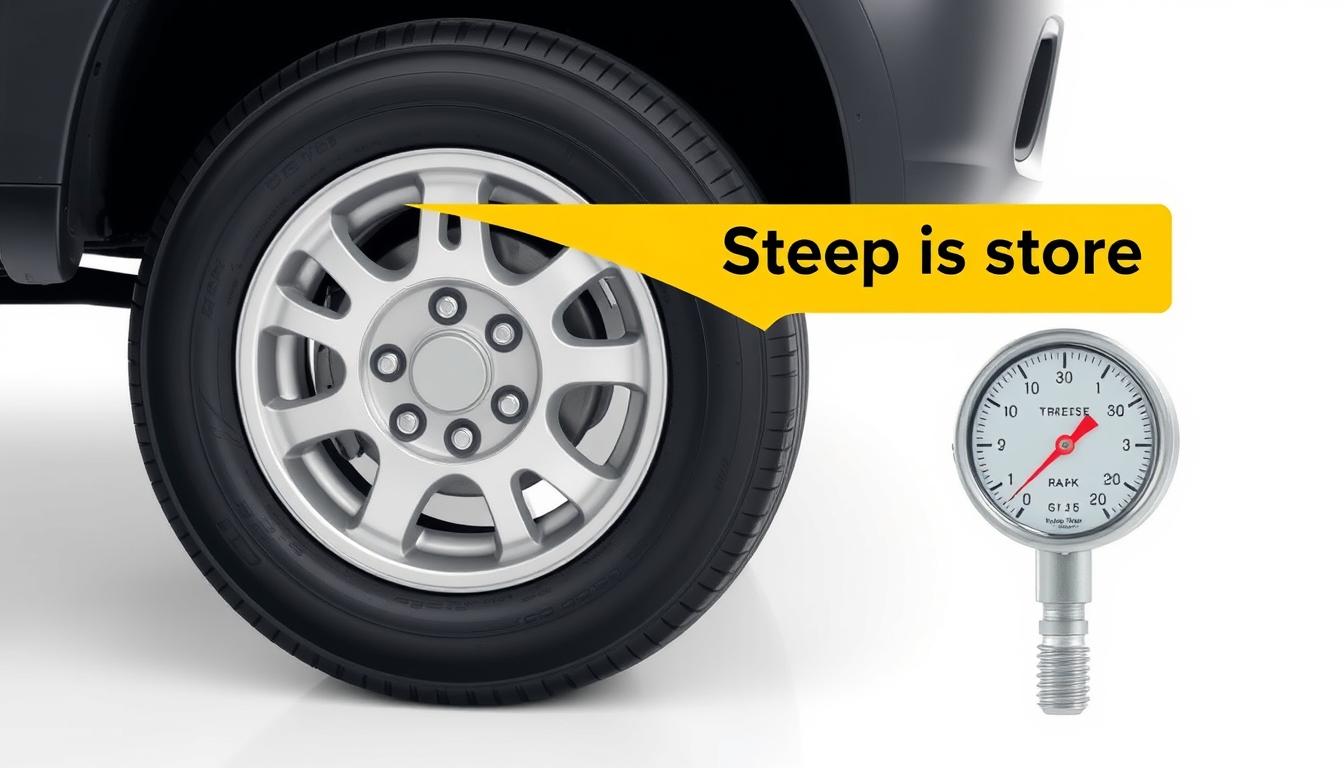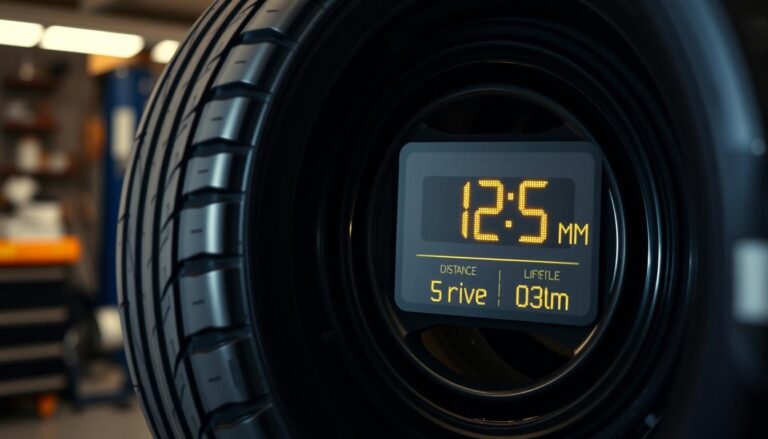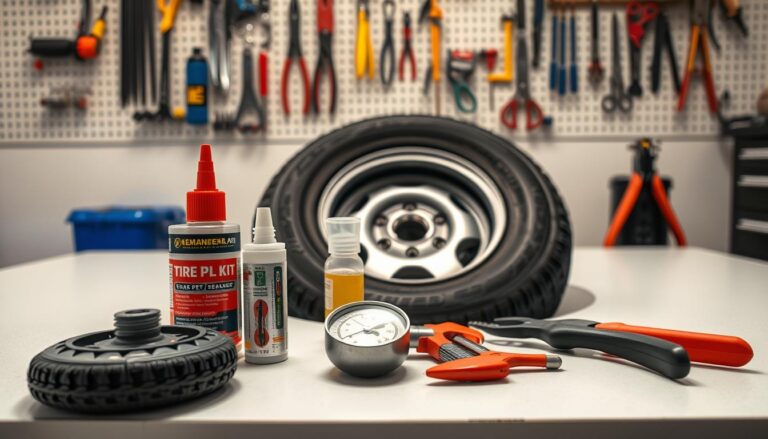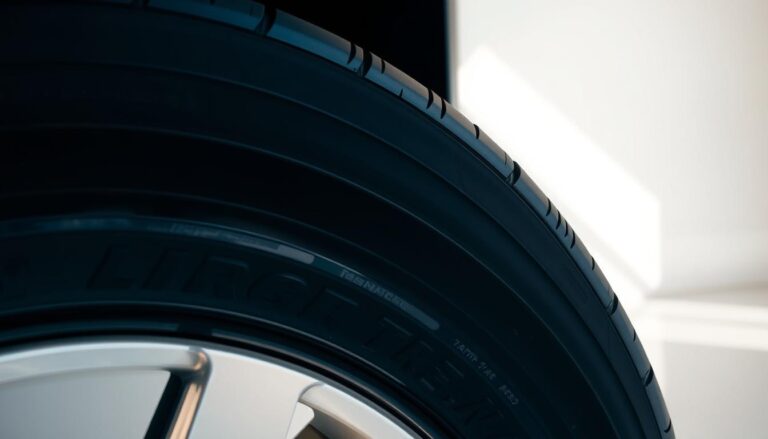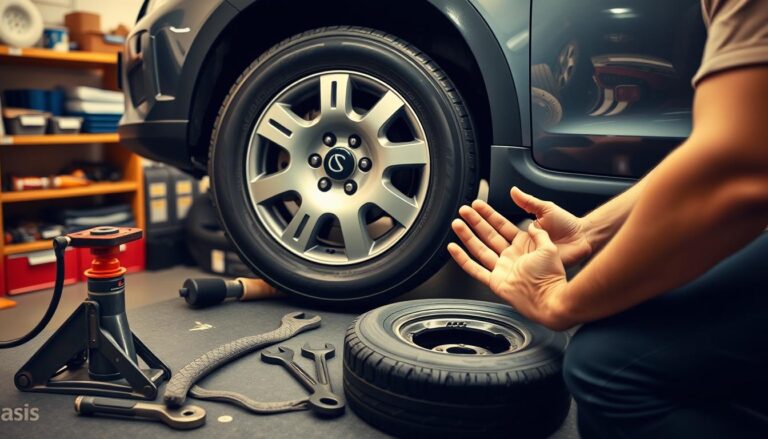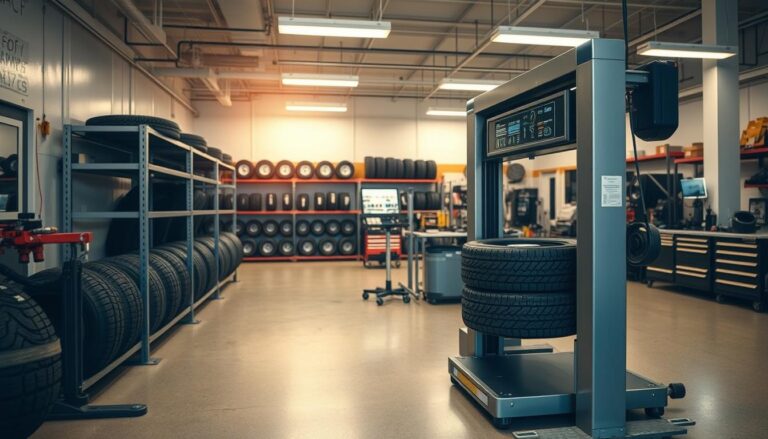The Quick Guide to Checking Tire Pressure
Keeping the right tire pressure is key for safety and performance. It affects your car’s fuel use and how well it drives. Learning to check tire pressure can save money and prevent emergencies.
Checking tire pressure might seem hard, but it’s easy. It’s important for any driver, whether you’re going on a long trip or just driving to work. Knowing how to manage tire pressure is a must.
This guide will teach you all about tire pressure. You’ll learn what tools you need and how to measure accurately. Keeping your tires properly inflated is more than avoiding flat tires. It’s about making sure your car runs its best.
Drivers who check tire pressure often see big benefits. They use less fuel, their cars handle better, and they’re less likely to get a tire blowout. Plus, their tires last longer. Just a few minutes of checking tire pressure can keep you safe and save you money.
In this guide, you’ll find useful tips and expert advice. It will make checking tire pressure easy and routine. Get ready to become a pro at keeping your vehicle safe and running well.
Understanding the Importance of Proper Tire Pressure
Keeping your tires at the right pressure is key for every car owner. It’s not just about checking them now and then. It’s about keeping your car safe, running well, and saving money.
https://www.youtube.com/watch?v=-HRridfF0DI&pp=ygUHI3V0aXJlcw%3D%3D
Many drivers don’t realize how big of a deal proper tire pressure is. But it really makes a difference in how your car drives.
Safety Benefits of Maintained Tire Pressure
Right tire pressure is a big deal for safety. If your tires are not just right, it can mess with:
- How your car handles and steers
- How well it brakes
- How it grips the road
- The chance of a tire blowout
Fuel Efficiency and Cost Savings
Keeping your tires at the right pressure can really cut down on gas use. If your tires are off, they work harder, using more gas.
| Tire Pressure Status | Fuel Efficiency Impact | Annual Cost Implications |
|---|---|---|
| Properly Inflated | Optimal Performance | Maximum Savings |
| Underinflated | 3-5% Fuel Waste | $100-$200 Extra Costs |
| Overinflated | Uneven Wear | Potential Tire Replacement |
Tire Longevity and Performance
Keeping your tire pressure up makes your tires last longer and your car run better. Correct inflation prevents early wear and keeps tread even, making your tires last longer.
By keeping your tire pressure right, you make your car safer, use less gas, and save money on repairs.
Essential Tools for Checking Tire Pressure
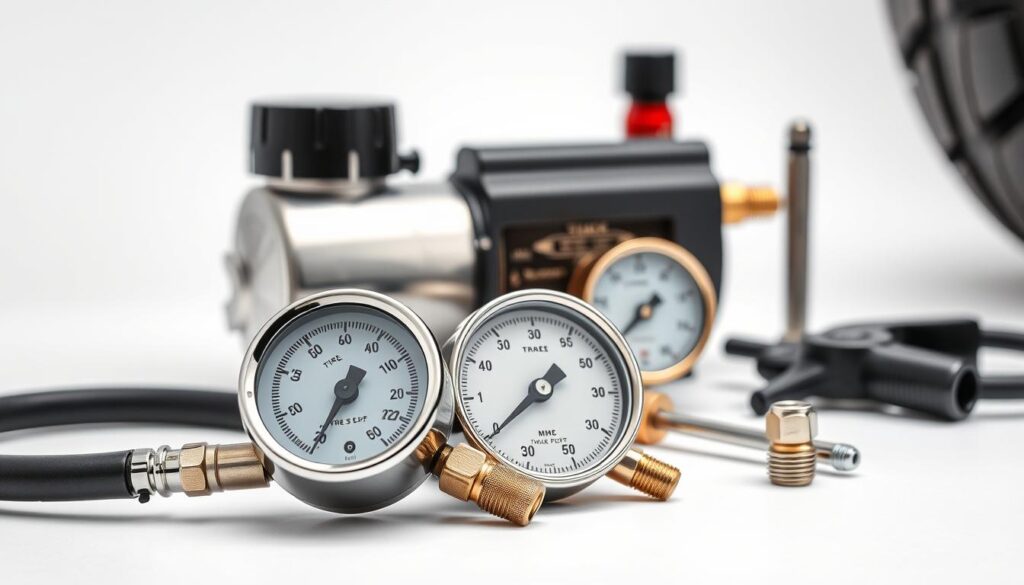
Getting the right tools is key for checking tire pressure. A good tire pressure gauge is essential for your vehicle’s health. There are many types of gauges, each with its own benefits.
When picking a tire pressure gauge, think about these main types:
- Digital Tire Pressure Gauges: Give exact digital readings with clear displays
- Analog Pressure Gauges: Old-school mechanical gauges that work well
- Stick-Type Gauges: Small and cheap, perfect for quick checks
Experts say to have more than one tool in your car. A portable air compressor is great with your gauge. It lets you inflate tires right away.
When choosing a tire pressure gauge, look for these features:
- How accurate it is
- How long it lasts
- How easy it is to use
- If it needs batteries (for digital ones)
- If it fits your car’s tire valves
Buying a top-notch tire pressure gauge helps you keep up with maintenance. It also helps spot tire problems early.
How to Check Tire Pressure: Step-by-Step Guide
Keeping your tires at the right pressure is key for safety and performance. Knowing how to check tire pressure can prevent problems and make your tires last longer. This guide will show you how to monitor tire pressure correctly.
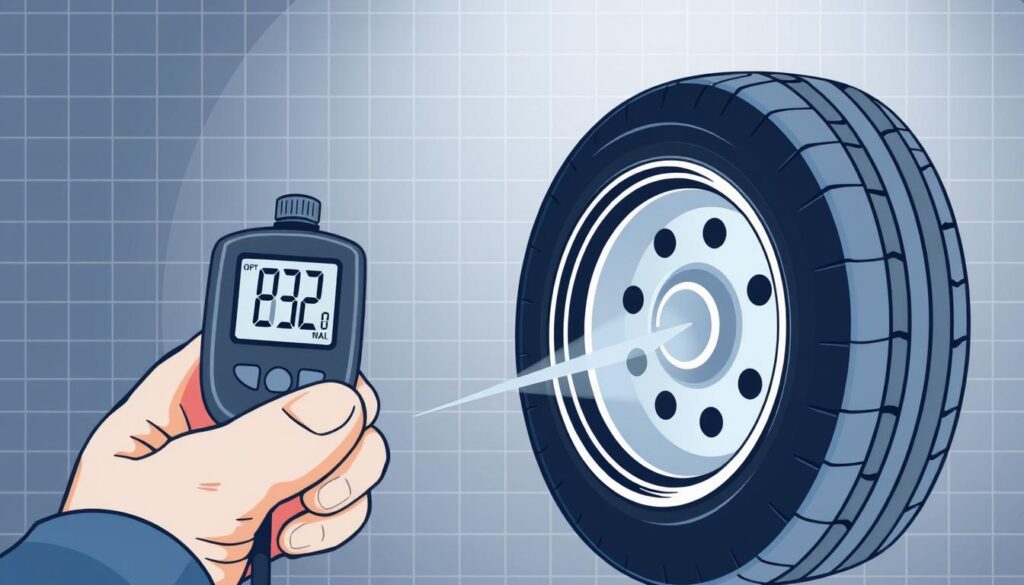
Finding the Correct Pressure Specifications
Finding the right tire pressure is the first step in tire care. You can find your vehicle’s recommended pressure in three places:
- Driver’s side door jamb
- Vehicle owner’s manual
- Inside the fuel door
The recommended pressure is in pounds per square inch (PSI). Always use the pressure your vehicle’s maker suggests, not the highest number on the tire.
Best Time to Check Pressure
Checking tire pressure is most accurate when tires are cold. Here’s when to check:
- In the morning before driving
- After the car has been parked for at least three hours
- At least once a month
Reading the Tire Pressure Gauge
To check tire pressure, follow these steps:
- Remove the valve stem cap
- Press the tire pressure gauge firmly onto the valve stem
- Read the pressure displayed on the gauge
- Compare the reading with recommended PSI
- Add or release air as needed
Digital tire pressure gauges give the most accurate readings. Remember, temperature changes can affect tire pressure. So, regular checks are vital for your vehicle’s performance and safety.
Common Mistakes When Measuring Tire Pressure
Checking tire pressure accurately is key for safety and performance. Many drivers make mistakes that affect their vehicle’s handling and fuel use.
Some common mistakes include:
- Checking tire pressure when tires are hot
- Neglecting to check the spare tire
- Relying solely on visual tire inspection
- Using an inaccurate or damaged pressure gauge
Experts say to avoid these mistakes. Temperature affects tire pressure readings. It’s best to check pressure when tires are cold, like in the morning.
Using a reliable digital tire pressure gauge is important. Cheap or old gauges can give wrong readings. Always check and replace your gauge to get accurate measurements.
Just looking at tires can be misleading. A tire might look fine but could be under or over-inflated. Relying on looks alone can be dangerous and wear out tires faster.
Knowing these mistakes helps drivers keep their vehicles running well. It improves fuel efficiency and road safety.
Understanding Your Tire Pressure Monitoring System (TPMS)
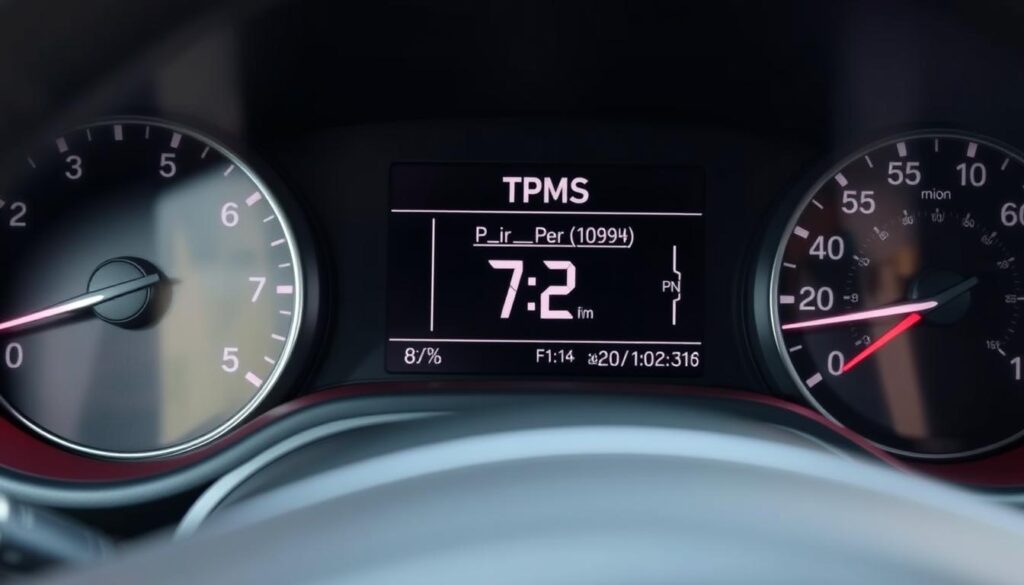
Modern cars have advanced tire pressure monitoring systems. These systems help keep you safe and your car running well. They give you important info about your tires in real-time, so you can fix problems before they get worse.
How TPMS Functions
Tire pressure monitoring systems have special sensors in each tire. These sensors send data to your car’s computer all the time. The computer checks this data and tells you if your tire pressure is too low.
- Direct TPMS uses individual wheel sensors
- Indirect TPMS relies on wheel speed sensor data
- Wireless sensors provide real-time pressure readings
Responding to TPMS Warnings
If your TPMS system warns you, act fast. Use a good gauge to check your tire pressure. Then, inflate or deflate as needed to meet the car maker’s standards. Ignoring these warnings can hurt your car’s fuel efficiency and safety.
System Maintenance and Calibration
Keeping your TPMS in good shape is key. Mechanics can calibrate it during car service. This makes sure your system works right and gives you accurate readings.
By knowing how your TPMS works and acting on its warnings, you can make your car safer. You’ll also save on fuel and make your tires last longer.
Seasonal Considerations for Tire Pressure
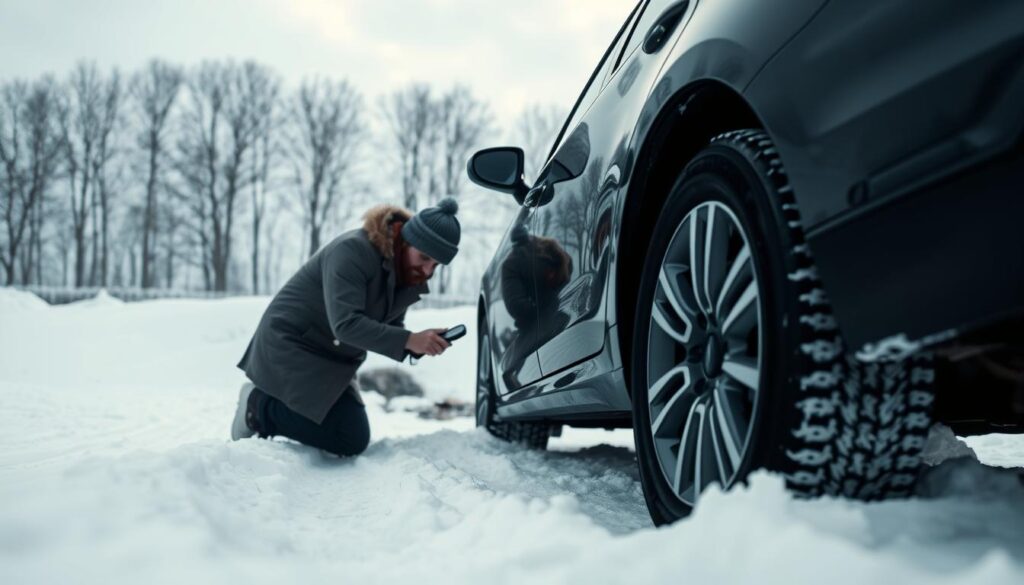
Tire pressure changes a lot with the seasons. Drivers need to know how weather affects their tires all year.
In winter, keeping the right tire pressure is key. Cold weather makes tire pressure go down a lot. For every 10-degree drop in temperature, tire pressure can fall by about 1 PSI. So, in winter, you should check tire pressure often to stay safe on the road.
- Winter: Check tire pressure every two weeks
- Summer: Check tire pressure monthly
- Spring/Fall: Monitor pressure during temperature transitions
Summer brings its own challenges for tire pressure. The heat makes tire pressure go up, which can cause overinflation. Drivers should adjust their tire pressure to what the manufacturer suggests for the best performance.
| Season | Temperature Impact | Recommended Action |
|---|---|---|
| Winter | Pressure Drops | More Frequent Checks |
| Summer | Pressure Increases | Regular Monitoring |
| Spring/Fall | Fluctuating Temperatures | Careful Pressure Adjustment |
Spending time on seasonal tire pressure checks can keep you safe and make your tires last longer. Always check your car’s manual for the right tire pressure for your vehicle.
When to Add or Release Air from Tires
Keeping your tires at the right pressure is key for safe driving and better car performance. Regular checks help you know when to add or remove air. Learning how to inflate and spotting warning signs can avoid safety risks and make your tires last longer.
Adjusting tire pressure needs careful attention and skill. Drivers should be ready to add or release air based on several important factors:
- Seasonal temperature changes
- Vehicle load conditions
- Recommended manufacturer specifications
- Driving terrain and conditions
Proper Inflation Techniques
Here’s how to add air to your tires correctly:
- Check the recommended PSI for your specific vehicle
- Use a reliable digital tire pressure gauge
- Remove the valve stem cap
- Attach the air compressor nozzle securely
- Inflate in short bursts, checking pressure frequently
Signs of Over and Under-Inflation
Spotting tire pressure issues is vital for maintenance. Under-inflated tires often show:
- Increased tire wear on outer edges
- Reduced fuel efficiency
- Decreased vehicle handling
- Potential sidewall damage
Over-inflated tires can have:
- Increased center tread wear
- Reduced traction
- Harsher ride quality
- Higher risk of punctures
Signs of Tire Pressure Problems
Spotting tire pressure issues early can prevent expensive fixes and safety hazards. Knowing the signs is key to keeping your tires in good shape.
Drivers should look out for several important signs during their tire checks:
- Uneven tire wear across the tire surface
- Noticeable changes in vehicle handling
- Decreased fuel efficiency
- Unusual vibrations while driving
- Tire sidewall bulges or visible damage
Visual checks are vital for tire pressure monitoring. Keep an eye out for these warning signs:
| Sign | Potential Pressure Issue |
|---|---|
| Center tread wearing faster | Over-inflation |
| Outer edges wearing quickly | Under-inflation |
| Sudden tire pressure warning light | Immediate pressure check required |
Regular tire checks can avoid these problems. Mechanics suggest checking tire pressure monthly and before long drives. This ensures your vehicle runs well and safely.
Conclusion
Knowing how to check tire pressure is key for every car owner. It’s not just a routine task; it’s a way to keep your car safe and running well. By following the tips in this guide, you can lower the risk of tire problems.
Regular checks help avoid sudden breakdowns and save on fuel. We’ve made it easy to monitor tire pressure, no matter your driving experience. Tools like digital gauges and TPMS systems make it simpler.
Keeping your tires at the right pressure is a small step towards safety. It can save you money, make your car more stable, and make your tires last longer. It’s not just about how your car performs; it’s about keeping everyone safe on the road.
Spending a few minutes to check tire pressure can make a big difference. It makes driving safer, smoother, and cheaper. Make it a must-do part of your car care routine.
